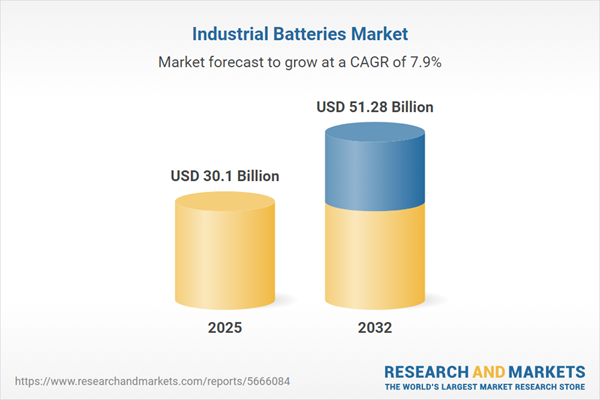Speak directly to the analyst to clarify any post sales queries you may have.
Industrial batteries are driving a strategic transformation in enterprise operations, enabling modernization, sustainable practices, and robust risk management for organizations navigating the shifting energy landscape. This report provides senior executives with a concise, actionable overview to inform battery procurement, deployment, and future-proof growth strategies.
Industrial Batteries Market Snapshot
The global industrial batteries market is undergoing rapid expansion, with the market size set to rise from USD 27.86 billion in 2024 to USD 30.10 billion by 2025 and projected to reach USD 51.28 billion by 2032. This growth is underpinned by a compound annual growth rate of 7.92%. Accelerated electrification across industries, infrastructure upgrades, and strategic integration of renewable energy sources are central drivers. As organizations emphasize scalable energy storage and business continuity, innovative advances in battery chemistry—such as next-generation lithium-ion and advanced lead-acid systems—are delivering modular, reliable solutions. Market leaders are responding with products that accommodate dynamic deployment and evolving compliance environments, boosting resilience and operational agility.
Scope & Segmentation: Industrial Batteries Market
This report equips decision-makers with detailed segmentation and analysis to shape high-impact procurement and investment strategies within the industrial batteries market:
- Battery Chemistry: Includes comprehensive reviews of established and next-generation options such as lead acid (flooded, VRLA, AGM, gel), lithium-ion variants (LiFePO4, LTO, NMC), and nickel cadmium. Segment relevance covers compliance, sector-specific performance, and emerging regional demand.
- Product Types: Focuses on portable, stationary, and traction batteries that fulfill requirements ranging from mobile operations to infrastructure backup and energy management.
- Applications: Explores use cases for backup power, grid-level storage, continuous heavy machinery operation, and telecom sector reliability, supporting critical infrastructure with consistent uptime.
- End-User Industries: Addresses the needs of energy and power, automotive, electronics, oil and gas, telecommunications, and transportation organizations seeking advanced battery integration.
- Capacity Ranges: Reviews solutions spanning from compact units below 100Ah to large-scale systems exceeding 500Ah, with recommendations for specific operational needs.
- Installation Types: Contextualizes deployment strategies for both indoor and outdoor environments, including centralized management scenarios and remote site requirements.
- Distribution Channels: Examines direct purchasing, strategic partnerships, and e-commerce channels that streamline supply chains and enable flexible procurement approaches.
- Geographical Coverage: Provides region-specific insight for North America (U.S., Canada), Latin America (Brazil), Europe, Middle East, Africa, and Asia-Pacific, with analysis of regulatory transitions and distinct local growth factors.
- Key Companies Profiled: Highlights advancements and partnerships among leaders such as Contemporary Amperex Technology Co., LG Energy Solution, BYD Company, Panasonic Corporation, Samsung SDI, SK On, Tesla, EnerSys, GS Yuasa Corporation, and Saft Groupe S.A.
Key Takeaways: Industrial Batteries Segments
- Redesigned battery materials and innovative system architectures enable enterprises to streamline retrofitting and accelerate modernization of energy infrastructure.
- Implementation of AI-driven battery management software enhances predictive maintenance, supporting critical uptime and operational reliability in enterprise environments.
- Uptake of industrial batteries directly supports enterprise sustainability targets by ensuring stable backup power and dependable energy delivery across diverse operational settings.
- Tailored system designs increase energy reliability, minimize operational downtime, and ensure flexibility for deployment in remote, distributed, or high-demand environments.
- Ongoing collaboration between manufacturers, utilities, and original equipment suppliers is driving the adoption of hybrid storage strategies, improving supply chain resilience and enabling sophisticated energy management.
- The report offers practical guidance to help organizations adapt to evolving compliance standards and market expectations in international contexts.
Impact of U.S. Tariffs on Market Dynamics
Recent U.S. tariffs are influencing how companies manage procurement within the industrial batteries sector. This shift is motivating enterprises to diversify their supplier networks, revise sourcing frameworks, and invest in local inventory. These measures are strengthening supply chain resilience and enhancing flexibility in response to market volatility.
Methodology & Data Sources
The analysis is built on primary interviews with technical executives and sector specialists, supplemented by thorough regulatory assessments and curated industry research. This methodological approach provides reliable and actionable insights for leaders making investment and deployment decisions for industrial batteries.
Why This Report Matters for Senior Decision-Makers
- Gain current insights on technological trends and evolving regulations that directly influence industrial batteries strategies and compliance considerations.
- Utilize robust market intelligence to refine procurement tactics, optimize supply chain reliability, and guide decisions on regional expansion initiatives.
- Identify promising investment opportunities and foster industry partnerships to align with dynamic changes in the global energy sector.
Conclusion
This report serves as an essential guide for senior executives optimizing battery storage investments, strengthening operational resilience, and aligning with sustainability objectives in an evolving industrial batteries landscape.
Additional Product Information:
- Purchase of this report includes 1 year online access with quarterly updates.
- This report can be updated on request. Please contact our Customer Experience team using the Ask a Question widget on our website.
Table of Contents
3. Executive Summary
4. Market Overview
7. Cumulative Impact of Artificial Intelligence 2025
Companies Mentioned
The companies profiled in this Industrial Batteries market report include:- Contemporary Amperex Technology Co., Limited
- LG Energy Solution, Ltd.
- BYD Company Limited
- Panasonic Corporation
- Samsung SDI Co., Ltd.
- SK On Co., Ltd.
- Tesla, Inc.
- EnerSys
- GS Yuasa Corporation
- Saft Groupe S.A.
Table Information
| Report Attribute | Details |
|---|---|
| No. of Pages | 184 |
| Published | November 2025 |
| Forecast Period | 2025 - 2032 |
| Estimated Market Value ( USD | $ 30.1 Billion |
| Forecasted Market Value ( USD | $ 51.28 Billion |
| Compound Annual Growth Rate | 7.9% |
| Regions Covered | Global |
| No. of Companies Mentioned | 11 |









